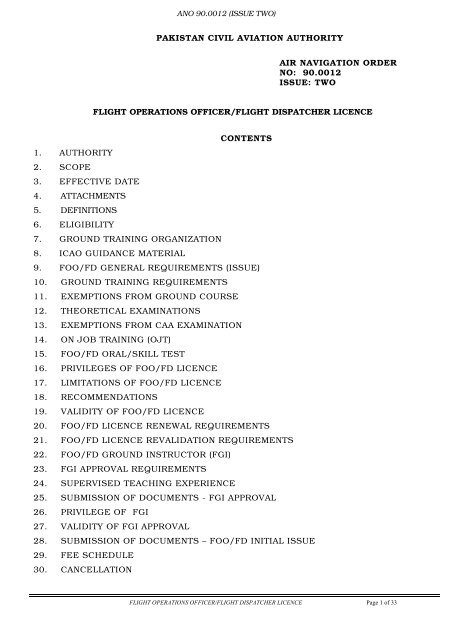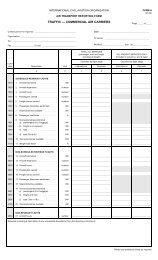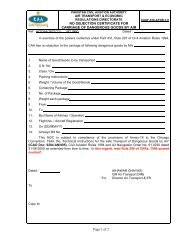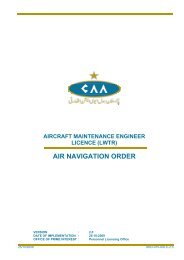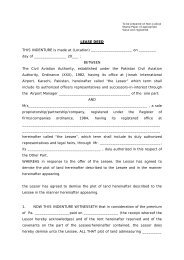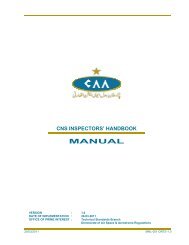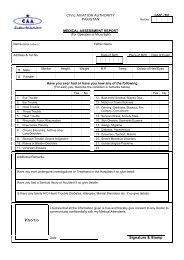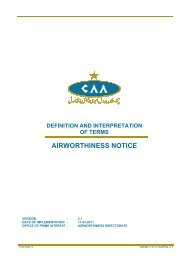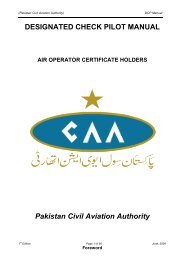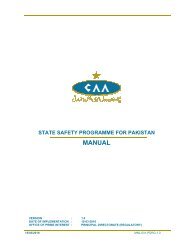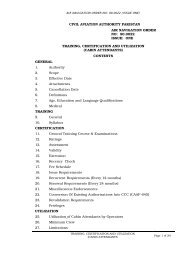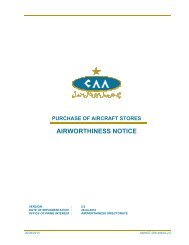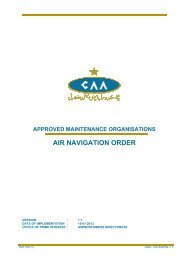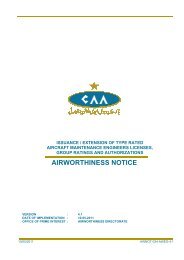90.0012 issue: two flight operations officer/flight dispatcher licen
90.0012 issue: two flight operations officer/flight dispatcher licen
90.0012 issue: two flight operations officer/flight dispatcher licen
You also want an ePaper? Increase the reach of your titles
YUMPU automatically turns print PDFs into web optimized ePapers that Google loves.
DEFINITIONSTANO <strong>90.0012</strong> (ISSUE TWO)PAKISTAN CIVIL AVIATION AUTHORITYAIR NAVIGATION ORDERNO: <strong>90.0012</strong>ISSUE: TWOFLIGHT OPERATIONS OFFICER/FLIGHT DISPATCHER LICENCECONTENTS1. AUTHORITY2. SCOPE3. EFFECTIVE DATE4. ATTACHMENTS5. T6. ELIGIBILITY7. GROUND TRAINING ORGANIZATION8. ICAO GUIDANCE MATERIAL9. FOO/FD GENERAL REQUIREMENTS (ISSUE)10. GROUND TRAINING REQUIREMENTS11. EXEMPTIONS FROM GROUND COURSE12. THEORETICAL EXAMINATIONS13. EXEMPTIONS FROM CAA EXAMINATION14. ON JOB TRAINING (OJT)15. FOO/FD ORAL/SKILL TEST16. PRIVILEGES OF FOO/FD LICENCE17. LIMITATIONS OF FOO/FD LICENCE18. RECOMMENDATIONS19. VALIDITY OF FOO/FD LICENCE20. FOO/FD LICENCE RENEWAL REQUIREMENTS21. FOO/FD LICENCE REVALIDATION REQUIREMENTS22. FOO/FD GROUND INSTRUCTOR (FGI)23. FGI APPROVAL REQUIREMENTS24. SUPERVISED TEACHING EXPERIENCE25. SUBMISSION OF DOCUMENTS - FGI APPROVAL26. PRIVILEGE OF FGI27. VALIDITY OF FGI APPROVAL28. SUBMISSION OF DOCUMENTS – FOO/FD INITIAL ISSUE29. FEE SCHEDULE30. CANCELLATIONFLIGHT OPERATIONS OFFICER/FLIGHT DISPATCHER LICENCE Page 1 of 33
ANO <strong>90.0012</strong> (ISSUE TWO)PAKISTAN CIVIL AVIATION AUTHORITYAIR NAVIGATION ORDERNO: <strong>90.0012</strong>ISSUE: TWOFLIGHT OPERATIONS OFFICER/FLIGHT DISPATCHER LICENCE1. AUTHORITY1.1. TThis Air Navigation Order (ANO) is <strong>issue</strong>d by the Director General Pakistan CivilAviation Authority (DG PCAA) in exercise of powers vested in him under Rules 4,45, 46, 47, 354 and 360 of Civil Aviation Rules 1994 (CARs’ 94).2. SCOPE2.1. This ANO relates to the <strong>issue</strong>, renewal and revalidation of Flight OperationsOfficer (FOO/FD) Licence <strong>issue</strong>d under the Civil Aviation Rules.2.2. This ANO relates to the <strong>issue</strong> and renewal of Ground Instructor FOO/FD (FGI)Approval.2.3. This ANO relates to the conduct of Basic FOO/FD course at the Ground TrainingOrganization (GTO).2.4. Unless contrary intentions appear, this ANO shall also be read in conjunctionwith the ANO 90.0001 (General Licensing Procedures), ANO 90.0002 (CAATechnical Examinations), ANO 90.0003 (Basic Flying Training), ANO 90.0004(Licences & Ratings – Aircrew), Air Safety Circulars (Licensing) and Instructions<strong>issue</strong>d by the CAA from time to time.3. EFFECTIVE DATE3.1. This ANO shall come into force with immediate effect.4. ATTACHMENTS4.1. ATTACHMENT `A’ : FOO/FD Basic Course4.2. ATTACHMENT ‘B’ : FOO/FD Licence Application Form (CAAF- 600-4)4.3. ATTACHMENT ‘’C’ : FOO/FD Skill Test Report Form CAAF-6424.4. ATTACHMENT ‘D’ : FOO/FD OJT Record (CAAF-642-1)4.5. ATTACHMENT ‘E’ : FOO/FD Oral Assessment (CAAF-606)5. DEFINITIONS5.1. When the following terms are used, they have the following meaning:‘Authority’ means Pakistan Civil Aviation Authority established under Section 3of Civil Aviation Ordinance 1982.‘Air Navigation Order’ means order <strong>issue</strong>d by the Director General, PakistanCivil Aviation Authority under the Civil Aviation Rules.FLIGHT OPERATIONS OFFICER/FLIGHT DISPATCHER LICENCE Page 2 of 33
ANO <strong>90.0012</strong> (ISSUE TWO)‘Air Safety Circular’ means Circulars <strong>issue</strong>d by the Director General, PakistaniCivil Aviation Authority, or a person authorized under Rule 5 of the Civil AviationRules 94.‘AOC’ mean Air Operator Certificate <strong>issue</strong>d by the CAA under the Civil AviationRules.‘Approved by the Authority’ means approved by the Director General, PakistanCivil Aviation Authority or his/her Delegated Representative.‘Approved Person’ means a person approved in written by the authorizedperson as Designated Examiner / Instructor.‘Aviation Training Centre’ means an Aviation Training Centre approved by theLicensing Authority; for the purpose of ground and/or flying training for <strong>issue</strong>,renewal and re-validation of a Personal Licences, Certificates, Ratings or anEndorsement under the Civil Aviation Rules 94.‘Designated Examiner’ means an Approved Person.`Flight Dispatcher’ means FOO/FD or Flight Operations Officer.‘ETOPS’ means Extended Twin Engine Operation.‘Flight Plan’ means specified information provided to air traffic services units,relative to an intended <strong>flight</strong> or portion of <strong>flight</strong> of an aircraft.‘Flight Operations Officer Licence’ means a Flight Operation Officer/FlightDispatcher Licence (FOO/FDL).‘FGI’ means a FOO/FD Ground Instructor.‘Ground Training Organization (GTO)’ means a Ground Training Organization(GTO) imparting training for the <strong>issue</strong> of a FOO/FD with a valid Approval fromCAA.‘MNPS’ means Minimum Navigation Performance Specifications.‘Operational <strong>flight</strong> plan’ means the operator’s plan for the safe conduct of the<strong>flight</strong> based on considerations of aircraft performance, other operatinglimitations and relevant expected conditions on the route to be followed and atthe aerodromes concerned.‘PCAA’ means Pakistan Civil Aviation Authority.‘Rating’ means an authorization entered on or associated with Licence orCertificate and forming part thereof, stating special conditions, privileges orlimitations pertaining to such <strong>licen</strong>se or certificate.‘Renewal’ means getting the Licence or Certificate renewed by meeting theRenewal requirements before the expiry of the validity period of Licence orCertificate.‘Revalidation’ means getting the Licence or Certificate revalidated, after theLicence or Certificate validity period has expired, by meeting the revalidationrequirements.‘RVSM’ means Reduced Vertical Separation Minima.FLIGHT OPERATIONS OFFICER/FLIGHT DISPATCHER LICENCE Page 3 of 33
ANO <strong>90.0012</strong> (ISSUE TWO)6. ELIGIBILITY FOR FOO/FD LICENCE6.1. AGE: Applicant shall not be less than 18 years of age.6.2. EDUCATION: Applicant shall hold an educational qualification of at least HigherSecondary School Certificate or equivalent with physics and mathematics.6.3. ENGLISH LANGUAGE PROFICIENCY: Applicant shall be capable of speaking,reading, writing and understanding English language.6.4. The applicant shall demonstrate compliance with the holistic descriptors asexplained below and as defined in ICAO Operational level 4 of the ICAOLanguage proficiency Rating scale as given in ICAO Annex 1.6.4.1. The Proficient speakers shall:6.4.1.1. Communicate effectively in voice-only (telephone/radiotelephone) and in face to face situations.6.4.1.2. Communicate on common, concrete and work related topicswith accuracy and clarity.6.4.1.3. Use appropriate communicative strategies to exchangemessages and to recognize and resolve misunderstandings in ageneral or work related context. (For example to check, confirmor clarify information)6.4.1.4. Handle successfully and with relative ease the linguisticchallenges presented by a complication or unexpected turn ofevents that occurs within the context of a routine work situationor communicative task with which they are otherwise familiar;and6.4.1.5. Use a dialect or accent, which is intelligible to the aeronauticalcommunity.6.5. NO OBJECTION CERTIFICATE (NOC): Serving personnel from Armed Forcesand Government Departments shall provide NOC from their Organization.7. GROUND TRAINING ORGANIZATION7.1. The Ground Training Organization conducting the Basic FOO/FD Course shallhold a valid approval from PCAA.7.2. The Flight Dispatch Center providing FOO/FD On-Job-Training (OJT) shall holda valid approval from PCAA as a Flight Dispatch Center and an additionalauthorization to conduct the FOO/FD On-Job-Training (OJT).8. ICAO GUIDANCE MATERIAL8.1. GTO shall use ICAO Training Manual (Doc 7192-AN/857 Part D-3 as guidancematerial for a ground training course for the <strong>issue</strong> of FOO/FD Licence.9. FOO/FD LICENCE GENERAL REQUIREMENTS (Issue)9.1. The applicant shall have:-9.1.1. Met the eligibility criteria.9.1.2. Undergone an approved FOO/FD Ground Theoretical Course.FLIGHT OPERATIONS OFFICER/FLIGHT DISPATCHER LICENCE Page 4 of 33
ANO <strong>90.0012</strong> (ISSUE TWO)9.1.3. Passed in the FOO/FD Theoretical Examinations.9.1.4. Undergone a minimum 90 days of On-Job-Training.9.1.5. Successfully passed the PCAA Oral/Skill Test.10. GROUND TRAINING REQUIREMENT10.1. THEORETICAL COURSE10.1.1. An applicant shall have successfully completed an Approved FOO/FDGround Theoretical Course in the subjects given below, with an approvedGround Training Organization (GTO):10.2. KNOWLEDGE10.2.1. The applicant shall have demonstrated a level of knowledge (TheoreticalWritten Examination) appropriate to the privileges granted to the holderof a Flight Operations Officer Licence in at least the following subjects:10.2.1.1. Aviation Law.10.2.1.1.1. Rules and Regulations relevant to the holder of aFlight Operations Officer/Dispatcher Licence;appropriate air traffic services practices andprocedures enforced in Pakistan;10.2.1.1.2. Contents of Operations Specifications.10.2.1.2. Aircraft General Knowledge10.2.1.2.1. Principles of operation of aeroplane powerplants,systems and instruments;10.2.1.2.2. Operating limitations of aeroplanes and powerplants;10.2.1.2.3. Minimum equipment list.10.2.1.3. Flight Performance Calculation and Planning Procedures10.2.1.3.1. Effects of loading and mass distribution on aircraftperformance and <strong>flight</strong> characteristics; mass andbalance calculation;10.2.1.3.2. Operational <strong>flight</strong> planning; fuel consumption andendurance calculations, alternate airport selectionprocedures, en-reroute cruise control and extendedrange operation;10.2.1.3.3. Preparation and filing of air traffic services <strong>flight</strong> plans;10.2.1.3.4. Basic principles of computer-assisted planningsystems;10.2.1.3.5. Consultation of aircraft Manual if required;10.2.1.3.6. Consultation of Contents of Operations Specifications.10.2.1.4. Meteorology10.2.1.4.1. Aeronautical meteorology; the movement of pressuresystems; the structure of fronts, and the origin andcharacteristics of significant weather phenomenawhich affect take-off, en-route and landing conditions;FLIGHT OPERATIONS OFFICER/FLIGHT DISPATCHER LICENCE Page 5 of 33
ANO <strong>90.0012</strong> (ISSUE TWO)10.2.1.4.2. Interpretation and application of aeronauticalmeteorological reports, charts and forecasts; codesand abbreviations; use of, and procedures forobtaining meteorological information.10.2.1.5. Navigation10.2.1.5.1. Principles of air navigation with particular reference toinstrument <strong>flight</strong>.10.2.1.6. Operational procedures10.2.1.6.1. Use of aeronautical documentation;10.2.1.6.2. Operational procedures for the carriage of freight anddangerous goods;10.2.1.6.3. Procedures relating to aircraft accidents; andincidents; emergency <strong>flight</strong> procedure;10.2.1.6.4. Procedures relating to unlawful interference andsabotage of aircraft;10.2.1.7. Principles of <strong>flight</strong>10.2.1.7.1. Principles of <strong>flight</strong> relating to appropriate category ofaircraft; and10.2.1.8. Radio communication10.2.1.8.1. Procedures for communicating with aircraft andrelevant ground stations.11. EXEMPTIONS FROM GROUND COURSE11.1. Applicants with under mentioned qualifications may be exempted from the FOOGround Course:11.1.1. Holder of a valid ATPL or a valid CPL with IR.11.1.2. A qualified Flight Navigator.11.1.3. A valid ATC Licence holder.11.1.4. An assistant FOO/FD with a 2 years experience in dispatchingCommercial Air Transport aircraft; subject to a satisfactory initialassessment in an Oral test by the CAA.11.2. The exemption from the FOO/FD ground course shall be withdrawn in case anapplicant fail to clear the CAA Examinations in a maximum of three attempts.12. THEORETICAL EXAMINATIONS12.1. For initial <strong>issue</strong> of FOO/FD Licence, an applicant shall be required to passFOO/FD-1 and FOO/FD-2 Examinations papers.12.2. For re-validation of an expired FOO/FD Licence (6 – 60 months period), anapplicant shall pass FOO/FD-R paper.12.3. For re-validation of an expired FOO/FD Licence for over 60 months period, anapplicant shall pass FOO/FD-1 and FOO/FD-2.12.4. Syllabus of FOO/FD-1FLIGHT OPERATIONS OFFICER/FLIGHT DISPATCHER LICENCE Page 6 of 33
ANO <strong>90.0012</strong> (ISSUE TWO)12.4.1. FOO/FD-1 paper shall consist of :12.4.1.1. Aviation Law12.4.1.2. Flight Performance Calculation and Planning Procedures.12.4.1.3. Operational procedures12.4.1.4. Meteorology (Reports, Charts & symbols only)12.5. Syllabus of FOO/FD-212.5.1. FOO/FD-2 paper shall consist of :12.5.1.1. Aircraft General Knowledge.12.5.1.2. Navigation.12.5.1.3. Principles of Flight.12.5.1.4. Radio Communication.12.5.1.5. Meteorology (other than Reports, Charts & symbols).12.6. Syllabus for FOO/FD-R12.6.1. FOO/FD-R paper shall consist of:12.6.1.1. Aviation Law (Civil Aviation Rules 1994).13. EXEMPTION FROM EXAMINATION13.1. The under mentioned shall be exempted from FOO-2 examination:13.1.1. A valid ATPL holder.13.1.2. A valid CPL holder with IR.13.1.3. A qualified Flight Navigator.14. ON JOB TRAINING (OJT)14.1. The applicant for <strong>issue</strong> of FOO/FD Licence shall have completed On Job training(OJT) under supervision of a Licensed Flight Operations Officer for at least 90days within 06 months immediately preceding the date of application in anApproved Flight Dispatch Centre. A prior authorization is required from theLicensing Office to commence the OJT; and the details of the OJT shall berecorded on form CAAF-642-1.14.2. The Flight Dispatch Center authorized to supervise the OJT of an applicant shallfully satisfy itself with regard to the competency of the applicant before issuingthe ‘OJT Completion Certificate’ which is the eligibility criteria for undergoing thefinal Oral/Skill Test with the CAA.14.3. The Flight Dispatch Center may extend the 90 days OJT period if the knowledgeand practical ability of the applicant is not upto the required standard. Anunusually high failure rate in the CAA Oral/Skill test, following the OJT, maylead to the cancellation of OJT approval to the Dispatch Center.14.4. During the OJT, an applicant shall have completed:14.4.1. Domestic Dispatch Operation14.4.1.1. Dispatched, under supervision, at least 05 domestic <strong>flight</strong>s.14.4.2. International Dispatch OperationFLIGHT OPERATIONS OFFICER/FLIGHT DISPATCHER LICENCE Page 7 of 33
ANO <strong>90.0012</strong> (ISSUE TWO)14.4.2.1. Dispatched, under supervision, at least 05 international <strong>flight</strong>s.15. ORAL/SKILL TEST15.1. The applicant shall have demonstrated the ability to the PCAA in the followingareas of knowledge and practical ability:15.1.1. Knowledge15.1.1.1. Contents of AOC and Operations Specification.15.1.1.2. Content of Operations Manual.15.1.1.3. Knowledge & application of Jeppesen Manual.15.1.2. Practical Ability15.1.2.1. Make an accurate and operationally acceptable weatheranalysis from a series of daily weather maps and weatherreports; provide an operationally valid briefing on weatherconditions prevailing in the general neighborhood of a specificair route; forecast weather trends pertinent to air transportationwith particular reference to destination and alternates;15.1.2.2. Determine the optimum <strong>flight</strong> path for a given segment andcreate accurate manual and/or computer generated <strong>flight</strong>plans;15.1.2.3. Provide operating supervision and all other assistance to a <strong>flight</strong>in actual or simulated adverse weather conditions asappropriate to the duties of a holder of Flight Operation OfficerLicence.16. PRIVILEGES OF FOO/FD LICENCE16.1. The privileges of a FOO/FD Licence are to:16.1.1. Assist the Pilot-in-Command in <strong>flight</strong> preparation and provide therelevant information required; and16.1.2. Prepare Operational and ATS <strong>flight</strong> plans, sign the document whenapplicable and file the ATS <strong>flight</strong> plan with the appropriate ATS facility;and16.1.3. Furnish the Pilot-in-Command while in <strong>flight</strong>, by appropriate means, withinformation that may be necessary for the safe conduct of <strong>flight</strong>; and16.1.4. In the event of an emergency, initiate such procedures as may beoutlined in the Operations Manual.17. LIMITATIONS OF FOO/FD LICENCE17.1. A Flight Operations Officer shall not:-17.1.1. Dispatch an aircraft of a type for which he has not received performancetraining.17.1.2. Shall not perform duty unless with the preceding 24 months he hasreceived recurrent training (refresher) in accordance with an approvedtraining programme conducted by an FGI.FLIGHT OPERATIONS OFFICER/FLIGHT DISPATCHER LICENCE Page 8 of 33
ANO <strong>90.0012</strong> (ISSUE TWO)21.1.1.1. Pass an Oral/Skill examination(CAAF-606); and21.1.1.2. Meet the renewal requirements.21.1.2. Between 06 to 60 months from the date of expiry of FOO/FDLicence:21.1.2.1. Pass FOO/FD-R; and21.1.2.2. Meet the renewal requirements.21.1.3. After 60 months of expiry of FOO/FD Licence:21.1.3.1. Pass FOO/FD-1 and FOO/FD 2;21.1.3.2. Pass PCAA ORAL/Skill Test; and21.1.3.3. Meet the renewal requirements.21.2. Holder of an expired FOO/FD Licence but with a verifiable record ofcontinuous job in Flight Dispatch Centre of a recognized foreign Operator;and holding Certificate/ Licence of the State, may be given a relaxation ofre-validation requirements to one degree lower.21.3. Holder of an expired FOO/FD Licence for not more than 60 months andholding valid CPL/IR or ATPL or a qualified current Navigator shall berequired to meet the renewal requirements; and Oral/Skill examinationfor re-validation of his FOO/FD Licence.21.4. Holder of an expired FOO/FD Licence for more than 60 months andholding valid CPL/IR or ATPL or a qualified current Navigator may begiven relaxation of re-validation requirements to one degree lower.22. FOO/FD GROUND INSTRUCTOR (FGI)22.1. Eligibility22.1.1. The Applicant shall:22.1.1.1. Hold or have held a FOO/FD Licence; or22.1.1.2. Hold or have held a ATP Licence; or22.1.1.3. Hold or have held a CPL/IR ; or22.1.1.4. A qualified Flight Navigator; or22.1.1.5. A qualified military pilot.22.1.1.6. A part time employee may be kept, with approval of PCAA,having qualification and experience in any of the specificFOO/FD subjects (e.g. met, theory of <strong>flight</strong>, Navigation,,dangerous goods) . Such an applicant, if approved, shall impartinstruction only in the subject for which he holds thequalification.22.2. APPLICANT STATUS22.2.1. The GTO shall have a minimum of 02 full time employee as FGI.23. FGI APPROVAL REQUIREMENTS23.1. The applicant shall meet FGI approval requirements in the sequence as givenbelow:FLIGHT OPERATIONS OFFICER/FLIGHT DISPATCHER LICENCE Page 10 of 33
ANO <strong>90.0012</strong> (ISSUE TWO)23.1.1. Meet the eligibility criteria.23.1.2. Pass the PCAA Instructional Technique paper.23.1.3. Pass the FOO/FD theoretical examination unless already passed; Parttime employee in a specific subject shall appear only in the specificsubject CAA examination.23.1.4. Carried out 05 days of OJT at an approved OJT Center unless holds aFOO/FD Licence or is a part time employee of on a specific subject.23.1.5. Successfully undergone the supervised teaching experience; and23.1.6. Has been given “Satisfactory” Skill Test Report by the supervising FGI.24. SUPERVISED TEACHING EXPERIENCE FOR FGI24.1. The applicant shall have conducted U<strong>two</strong>U FOO/FD Ground Courses in thefollowing order:24.2. The UFirstU course, which will be conducted by a qualified instructor, shall beparticipated on a full time basis by the applicant. During the entire period of thecourse, the applicant shall assist the qualified instructor in preparinginstructional course notes, setting examination questions, and also conductselected portions (20%-30%) of the course syllabus in presence of thesupervising FGI.24.3. The USecondU course shall be entirely conducted by the applicant in presence ofthe supervising FGI, who shall supervise the class on full time basis. This coursewill be conducted under intimation to the CAA.24.4. After satisfactory completion of the above <strong>two</strong> courses, the trainee FGI will be<strong>issue</strong>d with a ‘Satisfactory Skill Test Report’ by the supervising FGI on the basisof which CAA will approve the FGI.25. SUBMISSION OF DOCUMENTS – FGI APPROVAL25.1. For <strong>issue</strong> of FGI approval, the GTO shall submit the following documents:25.1.1. Application from the GTO.25.1.2. 04 Photographs 1x1 Inch of applicant.25.1.3. Education/Qualification/Experience Certificates evidence.25.1.4. Photocopies of Licences, Foreign qualifications and Courses, if applicable.25.1.5. Photocopy of National Identity Card.25.1.6. Photocopy of Passport (foreign nationals only).25.1.7. No Objection Certificate (NOC) from Concerned Armed Force/GovernmentDepartment, if applicable.25.1.8. Result of CAA Instructional Technique Course.25.1.9. FOO/FD OJT Record (CAAF- 642-1), if applicable.25.1.10. Result of FOO/FD Theoretical examinations, if applicable.25.1.11. Skill Test Report from the supervising FGI conducting the teachingexperience courses.25.1.12. Fee Voucher/Authorization.FLIGHT OPERATIONS OFFICER/FLIGHT DISPATCHER LICENCE Page 11 of 33
ANO <strong>90.0012</strong> (ISSUE TWO)26. PRIVILEGES OF FGI26.1. A FGI will exercise the privilege of conducting/teaching FOO/FD GroundCourses and FOO/FD recurrent training (Refresher) within the conditions andlimitations contained in the CAA approval.27. VALIDITY OF FGI APPROVAL27.1. An FGI approval will be valid for 01 year provided the holder is medically fit andis on a full time employment with a GTO.28. SUBMISSION OF DOCUMENTS - FOO/FD LICENCE28.1. For Issue of FOO/FD Licence28.1.1. For <strong>issue</strong> of FOO/FD Licence an applicant shall submit the followingdocuments:28.1.1.1. Application Form CAAF-600-4.28.1.1.2. Photocopy of Secondary School Certificate or EquivalentCertificate. (For D.O.B/Name).28.1.1.3. Photocopies of Certificates of higher education, other Licences,Foreign qualifications and Courses may also be attached.28.1.1.4. Photocopy of National Identity Card.28.1.1.5. Photocopy of Passport (foreign nationals only).28.1.1.6. 04 coloured photograph 1 X 1 Inch (Both ears visible, headuncovered).28.1.1.7. No Objection Certificate (NOC) from Concerned ArmedForce/Government Department, if applicable28.1.1.8. Ground Training Course Completion Certificate.28.1.1.9. CAA Technical Examination Results.28.1.1.10. OJT Certificate from Flight Dispatch Centre.28.1.1.11. FOO/FD OJT Record (CAAF- 642-1).28.1.1.12. Skill Test Report Form (CAAF-642).28.1.1.13. Copies of <strong>two</strong> Operational Flight Plans for the <strong>flight</strong>s dispatchedand signed by the applicant him self and supervised by a<strong>licen</strong>sed Flight Operation Officer.28.1.1.14. Fee Voucher/Authorization.28.2. For Renewal /Revalidation of FOO/FD Licence28.2.1. For Renewal/Revalidation of FOO/FD Licence an applicant shall submitthe following documents:28.2.1.1. Application Form CAAF-600-428.2.1.2. Job Experience Certificate from an Employer or OJT Certificatefrom Flight Dispatch CentreFLIGHT OPERATIONS OFFICER/FLIGHT DISPATCHER LICENCE Page 12 of 33
ANO <strong>90.0012</strong> (ISSUE TWO)28.2.1.3. OJT Record (CAAF- 642-1)28.2.1.4. Flight Operation Officer Licence (CAAF-665)28.2.1.5. Oral/Skill Test Report(CAAF-606) or Technical Result asapplicable28.2.1.6. Copies of <strong>two</strong> Operational Flight Plans for the <strong>flight</strong>s dispatchedand signed by the applicant him self and supervised by anauthorized Flight Operation Officer.28.2.1.7. Fee Voucher/Authorization.29. FEE SCHEDULE FOR FOO/FD LICENCE29.1. As per the CAA Fee Schedule (Personnel Licensing).30. CANCELLATION30.1. This ANO, when effective, cancels ANO 91. 00012 (Issue One).FLIGHT OPERATIONS OFFICER/FLIGHT DISPATCHER LICENCE Page 13 of 33
ANO <strong>90.0012</strong> (ISSUE TWO)1. INTRODUCTIONTHE FOO/FD BASIC COURSEATTACHMENT ‘A’ TO ANO <strong>90.0012</strong>1.1. This Air Navigation Order provides only a brief introduction to the FOO/FDBasic Ground Course. The FTO/GTO applying for the Approval from the CAA forconducting the FOO/FD Basic Ground Course is strongly advised to consult theICAO Training Manual (Doc 7192-AN/857 Part D-3 that provides the detailedtraining requirements. The FTO/GTO is required to break down the trainingrequirements down to the detailed contents of each lecture.2. FUNCTIONS OF A FOO/FD2.1. A <strong>flight</strong> <strong>operations</strong> <strong>officer</strong>/<strong>flight</strong> <strong>dispatcher</strong> (FOO/FD) is employed to providesupervision of <strong>flight</strong> and to act as a close link between aircraft in <strong>flight</strong> and theground services, and also between the air crew and the operator’s ground staff.3. TRAINING REQUIREMENTS3.1. The principal duties of the <strong>flight</strong> <strong>operations</strong> <strong>officer</strong>/<strong>flight</strong> <strong>dispatcher</strong> (FOO/FD)are as under:3.1.1. Assist the pilot-in-command in <strong>flight</strong> preparation and provide therelevant information required;3.1.2. Assist the pilot-in-command in preparing the operational and ATS <strong>flight</strong>plans, sign when applicable and file the ATS <strong>flight</strong> plan with theappropriate ATS unit;3.1.3. Furnish the pilot-in-command while in <strong>flight</strong>, by appropriate means, withinformation which may be necessary for the safe conduct of the <strong>flight</strong>;and3.1.4. In the event of an emergency, initiate such procedures as may beoutlined in the <strong>operations</strong> manual.3.1.5. The FOO/FD relieves the pilot- in-command of a considerable burden byproviding him with the opportunity to consult on critical and non-critical<strong>issue</strong>s with professionals who are familiar with all factors bearing on anoperation and have the knowledge of the whole ne<strong>two</strong>rk of <strong>operations</strong> ofwhich any particular <strong>flight</strong> is only a part.3.1.6. During <strong>flight</strong>, a continued assessment of <strong>flight</strong> conditions, the monitoringof fuel adequacy, and the recommendation of alternative plans such asdiversion necessitate an extension of the pre-<strong>flight</strong> duties throughout thecourse of the actual <strong>flight</strong> operation. The advent of improved ground/aircommunications allows the FOO/FD to relay to an aircraft informationreceived after it has become airborne, thus increasing the value of the“in-<strong>flight</strong>” assistance.2.1 The FOO/FD not only contributes to the safety and regularity of <strong>flight</strong><strong>operations</strong> but also makes a positive contribution to the economy andefficiency of aircraft operation by improving the payload, reducing excessivefuel reserve, positioning or repositioning the aircraft more efficiently, andsaving flying hours by reducing the number of abortive <strong>flight</strong>s. The FOO/FDmust constantly know the position and monitor the progress of all <strong>flight</strong>s in hisarea, and this involves a constant process of analysis, evaluation, consultationand decision. The FOO/FD must at all times have the courage of hisconvictions and let nothing influence him contrary to his better judgement.FLIGHT OPERATIONS OFFICER/FLIGHT DISPATCHER LICENCE Page 14 of 33
ANO <strong>90.0012</strong> (ISSUE TWO)2.2 In applying these basic philosophies and, in particular, bearing in mind theneed to keep the aircraft operating safely and efficiently, the FOO/FD mustalways:• Plan conservatively;• Failing normal operation, plan so as to give the best alternative service; and• Keep <strong>flight</strong>s operating on schedule in so far as possible.2.3 Planning must be based upon realistic assumptions since the Inevitable resultsof over optimism are delays, inconvenience to passengers and uneconomicalutilisation of the aircraft, all of which can impact the safety of operation.2.4 In preparing the necessary basic material and criteria that will help the pilotin-commanddecide on some of the essential features of each <strong>flight</strong>, theFOO/FD must:• Consult with the meteorological office and refer to meteorologicalinformation, as necessary;• Issue information concerning <strong>operations</strong> plans to the appropriatedepartments of the operator’s organisation;• Issue such instructions concerning aircraft and crew utilisation as arenecessary to the appropriate departments of the operator’s organisation;• Consider with the pilot-in-command the existence of and method ofensuring compliance with, noise abatement procedures;• Ascertain load requirements;• Determine load availability;• Outline to the pilot-in-command what may be expected in the way of enrouteand terminal weather, explain how other <strong>flight</strong>s have been planned orwhat they have encountered en route, indicating their altitude, procedure,ground speed, etc., and offer suggestions that may be of help to the pilot-incommandin his <strong>flight</strong> planning;• Advise the pilot-in-command on the routes, altitudes, tracks and technicalstops that will be necessary and what alternate aerodromes arc consideredsuitable for the various terminals, and why;• Determine fuel requirements, aircraft gross weight and balance (the pilotin-commandmakes an independent calculation);• Bring to the pilot-in-command’s attention any irregular operation of airport,airway, navigation or communication facilities, with particular regard tonoise curfews affecting the availability of airports; and• Outline what may be expected in the way of delays to or irregularities in the<strong>flight</strong> while en route or what is expected of other <strong>flight</strong>s operating over theroute at the same time.• During the in-<strong>flight</strong> stage, the FOO/FD must be ready to assist the pilot-incommand,for example:• by issuing such instructions concerning revised plans for aircraft and crewutilisation as are necessary w the appropriate departments of the operator’sorganization, if a diversion, <strong>flight</strong> return, en-route delay, or cancellationoccurs;• by recommending revised routes, altitudes and alternates;• by advising the pilot-in-command of commercial and technicalconsiderations of which he could not be aware and which could influenceFLIGHT OPERATIONS OFFICER/FLIGHT DISPATCHER LICENCE Page 15 of 33
ANO <strong>90.0012</strong> (ISSUE TWO)operational decisions, such as enforced diversion to an alternatedestination;• by monitoring adequacy of remaining fuel; and• by supplying or arranging for the supply of supplementary information(including significant weather information, irregularities in operation ofnavigation and communication facilities, etc.) to the pilot.2.5 When such irregularities in <strong>flight</strong> <strong>operations</strong> occur, the FOO/FD must look farahead and consider the many factors involved in order to determine the mostpractical plan or solution. Some of the main factors are as follows:• How long will the <strong>flight</strong> be delayed. or when is it expected to operate?• How long can the <strong>flight</strong> be delayed? The exigencies of crew <strong>flight</strong> timelimitation legislation render this consideration one of the critical factors in<strong>flight</strong> departure delays or <strong>flight</strong> time extension. The possible need to warn afresh crew or to revise the <strong>flight</strong> schedule must be foreseen and planned for.• In the event that the <strong>flight</strong> is delayed beyond the maximum limitestablished or is cancelled, what is the best alternative for passengers andcargo?• How will the delay affect other sections of the airline and can they keepoperating on schedule?• Is there an aircraft available to originate the <strong>flight</strong> at the next terminalahead and what is the most practical time to so originate?• What is the second best point to originate the <strong>flight</strong>?• What is the latest time the <strong>flight</strong> can originate and still allow necessaryplacement of aircraft?• Is there revenue available at the time origination is most desired?• If necessary to cancel, what is the best time in order to fit in withalternative transportation?• How can the plans of an FOO/FD be integrated by the FOO/FD who willnext handle the Flight?2.6 In the event of a security incident on an aircraft, the FOO/FD assumessignificant responsibilities for the operational aspects of any actions initiatedfrom the ground. He must also be prepared to render the pilot-in- commandand his crew every possible assistance during the emergency.2.7 Delays in and irregularities of operation often upset crew members andpassengers and may significantly affect aircraft cycles. Therefore, it isnecessary for the FOO/FD to check closely with the operator’s departmentsresponsible for crew and aircraft routing in order to maintain a well-balancedpositioning of crew and aircraft for the smooth operation of all <strong>flight</strong>s.3 Types of training3.1 To cover the various backgrounds of trainees, it is recommended that trainingbe divided into <strong>two</strong> phases as follows:• Phase one consists of basic knowledge; its completion ensures that atrainee has the necessary background to proceed with phase <strong>two</strong> of thetraining.• Phase <strong>two</strong> consists of applied practical training and route experience.3.2 Trainees who do not have previous aviation experience will have to undergo thecomplete training programme as recommended in phase one. Trainees whoFLIGHT OPERATIONS OFFICER/FLIGHT DISPATCHER LICENCE Page 16 of 33
ANO <strong>90.0012</strong> (ISSUE TWO)have had suitable aviation experience, however, may not need to undertakethis complete programme; for example, a professional pilot, a <strong>flight</strong> navigator,an air traffic controller, or a <strong>flight</strong> radio operator can be assumed to have, atleast, partially completed phase one if they have been actively employed inthese occupations within the past few years. In such cases, training institutes,with the approval of the CAA, are encouraged to apply the necessary flexibilityin arranging appropriate training courses, emphasising subjects of particularconcern to FOO/FD. The same flexibility can also be applied during requalificationor recurrent classroom training. Table 1-1 provides anapproximate duration for the training of the FOO/FD (phase one). It alsocontains a shortened training duration to serve as a guideline for the trainingof experienced personnel and for the re-qualification of FOO/FD.3.3 In using the curriculum recommended for the FOO/FD, local considerationsmay dictate the advisability of changing the sequence of the subjects. However,the relative importance accorded to each subject should, as much as possible,remain unchanged. The multiplicity of types of aircraft, navigation aids andoperational practices throughout the world makes it undesirable to define toorigidly many of the headings of the syllabus, and it is necessary to leave someflexibility to those in charge of the training course. Instructors must, however,ensure that all items in the training manual syllabus are adequately coveredand any requirements relevant to individual authorities should be treated asadditional subjects and not as substitutions for the recommended syllabus.Instructors must also ensure that all items required in the CAA <strong>licen</strong>singexamination are adequately covered. Any choices in the examination itselfshould be confined to the additional subjects dealing with those practices andprocedures which the trainee is most likely to use in the first period of hisduties as an FOO/FD. This choice of additional subjects will very often bemade easy by specific requests by operators, and by the type of aircraft usedoperationally.4 Standard of accomplishment4.1 Each training objective is described with reference to the establishment ofconditions, performance and a standard of accomplishment. The conditionsdescribe the scenario where trainee performance will be developed and testedwhile indicating whether actual equipment, mock-ups, or simulators, etc., areto be used. The standard of accomplishment establishes the level of traineeperformance that must be attained and may differ from school to schooldepending on the training equipment available.4.2 In measuring the standard of accomplishment, the use of only <strong>two</strong> grades,pass and fail, is recommended. It must, however, be noted that many trainingestablishments prefer to use a numerical grading system as trainees striveharder and learn more when rewards increase. If the same grade, pass, is givenfor a 99 per cent score as for a 75 per cent score, trainees may not strive forperfection.5 Training reference guide5.1 Table 1-1 presents the recommended duration (in hours) of the varioussubjects that need to be covered during phase one training (basic knowledge)for trainees with and without previous aviation experience, and Phase <strong>two</strong>(applied practical training). In appreciation of the fact that differences inrequirements may necessitate changes in the suggested syllabus to allowcompletion of the course within the period allotted for training, the total hoursrequired for the completion of a subject are given. Instructors should, however,ensure that all sections of the syllabus are adequately covered to the necessarydegree in order to meet the desired level of accomplishment before the traineesare assigned to phase <strong>two</strong> training.FLIGHT OPERATIONS OFFICER/FLIGHT DISPATCHER LICENCE Page 17 of 33
ANO <strong>90.0012</strong> (ISSUE TWO)5.2 In addition, the various parts of the course have been marked with a codingfrom I to 4 indicating an increasing degree of expertise to clarify understandingof the desired level of accomplishment.• 1 — denotes a basic knowledge of a subject. Trainees should have a basicunderstanding of the subject but are not expected to apply that knowledge.• 2 — denotes knowledge of the subject and the ability, where applicable, toapply it in practice with the help of reference materials and instructions.• 3 — denotes a thorough knowledge of the subject and the ability to apply itwith speed and accuracy.• 4 — denotes extensive knowledge of the subject and the ability to applyprocedures derived from it with judgement appropriate to the circumstances.6. CONTENTS OF THE COURSEINTRODUCTIONTraining PrincipleRegulatory requirements Training requirements.AIR LAWCivil air law and regulationsIntroductionTraining objectivesRequired knowledge, skill and attitudeAviation indoctrinationIntroductionRegulatoryAviation terminology and terms of referenceTheory of <strong>flight</strong> and <strong>flight</strong> <strong>operations</strong>.Aircraft propulsion systemsAircraft systemsAircraft mass (weight) and performanceIntroductionBasic principles for <strong>flight</strong> safetyBasic mass and speed limitations.Take-off runway requirementsClimb performance requirements.Landing runway requirementsBuffet boundary speed limitation.NavigationIntroductionTraining objectivesRequired knowledge, skill and attitudeThe CNS/ATM conceptAir Traffic ManagementFLIGHT OPERATIONS OFFICER/FLIGHT DISPATCHER LICENCE Page 18 of 33
ANO <strong>90.0012</strong> (ISSUE TWO)IntroductionTraining objectivesRequired knowledge, skill and attitudeMeteorologyIntroductionTraining objectivesRequired knowledge, skill and attitudeMass (Weight and Balance)IntroductionTraining objectivesRequired knowledge, skill and attitudeTransportation of Dangerous Goods by AirIntroductionTraining ObjectiveRequired knowledge, skill and attitudeFlight PlanningIntroductionTraining ObjectiveRequired knowledge, skill and attitudeFlight MonitoringIntroductionTraining ObjectiveRequired knowledge, skill and attitudeCommunications – RadioIntroductionTraining ObjectiveRequired knowledge, skill and attitudeHuman FactorsIntroductionThe meaning of Human FactorsDispatch resource management (DRM)AwarenessPractice and feedbackReinforcementTraining ObjectivesRequired knowledge, skill and attitude.Security (Emergencies and abnormal situations)IntroductionTraining ObjectiveRequired knowledge, skill and attitudeFLIGHT OPERATIONS OFFICER/FLIGHT DISPATCHER LICENCE Page 19 of 33
ANO <strong>90.0012</strong> (ISSUE TWO)Practical ExperienceIntroductionApplied practical <strong>flight</strong> <strong>operations</strong>Simulator LOFT observation and synthetic <strong>flight</strong> trainingFlight dispatch practices (On the Job Training)Route familiarization6 MINIMUM TRAINING HOURS REQUIREMENT6.1 There will be <strong>two</strong> phases of training as follows namely PHASE ONE (BasicKnowledge) and PHASE TWO (Applied Practical Knowledge).7 PHASE ONE - BASIC KNOWLEDGE7.1 Recommended duration and degree of expertise for phase one and phase <strong>two</strong>training.Subject MatterRecommended duration (Hours)TraineeswithoutpreviousaviationexperienceTraining withprevious aviationexperienceCivil air law and regulations. 30 18Certification of operators 2The Convention on2International Civil Aviation(The Chicago Convention)International air transport<strong>issue</strong>s addressed by theChicago ConventionThe International Civil AviationOrganization (ICAO)Responsibility for aircraftairworthinessRegulatory provisions of the<strong>flight</strong> manualThe aircraft minimumequipment list (MEL)The <strong>operations</strong> Manual 3Aviation indoctrination 12 6Regulatory 3Aviation terminology and termsof refer34enceTheory of <strong>flight</strong> and <strong>flight</strong><strong>operations</strong>Aircraft propulsion systems 2Aircraft systems 2Aircraft mass (weight) andperformance27 152233332Degree ofexpertiseFLIGHT OPERATIONS OFFICER/FLIGHT DISPATCHER LICENCE Page 20 of 33
ANO <strong>90.0012</strong> (ISSUE TWO)Basic principles for <strong>flight</strong>safetyBasic mass (weight ) and speedlimitationsTake-off runway requirements 3ClimbrequirementsperformanceLanding runway requirements 3Buffet boundary speedlimitationsNavigation 24 12Position and distance; time 3True, magnetic and compass2direction; gyro headingreference and grid directionIntroduction to chart2projections: The gnomonicprojection; the Mercatorprojection; great circles onMercator charts; othercylindrical projection; Lambertconformal conic projection; thepolar stereographic projection.ICAO chart requirements 3Charts used by typicaloperatorMeasurement of airspeeds;track and ground speedUse of slide-rules, computersand scientific calculatorsMeasurement of aircraftaltitudePoint of no return; criticalpoint; general determination ofaircraft position.Introduction to radionavigation; ground-basedradar and direction-findingstations; relative bearings;VOR/DME- type radionavigation; instrument landingsystemsNavigation procedures 1Air Traffic management 39 21Introduction to air trafficmanagementControlled airspace 3Flight Rules 333333333322FLIGHT OPERATIONS OFFICER/FLIGHT DISPATCHER LICENCE Page 21 of 33
ANO <strong>90.0012</strong> (ISSUE TWO)ATC clearance; ATCrequirements for <strong>flight</strong> plan;aircraft reportsFlight information service (FIS) 3Alerting service and searchand rescueCommunications(Mobile, fixed)Aeronauticalservice (AIS)servicesinformationAerodrome and airport services 3Meteorology 42 21Atmosphere; atmospherictemperature and humidityAtmospheric pressure;pressure – wind relationshipsWinds near the Earth’ssurface; wind in the freeatmosphere; turbulenceVertical motion in theatmosphere; formation ofclouds and precipitationThunderstorms; upper-airobservations; station modelVisibility and RVR; volcanicashSurface observation s; upperairobservations; station modelAir mass and fronts; frontaldepressionsWeather at fronts and otherparts of the frontal depression;other types of pressuresystemsGeneral climatology; weatherin the tropicsAeronautical meteorologicalreports; analysis of surfaceand upper-air chartsPrognostic charts; aeronauticalforecastsMeteorological service forinternational air navigationField trip to localmeteorological officeMass (weight) and balancecontrolIntroduction to mass andbalance27 15Load planning 33333223233322133423FLIGHT OPERATIONS OFFICER/FLIGHT DISPATCHER LICENCE Page 22 of 33
ANO <strong>90.0012</strong> (ISSUE TWO)Calculation of payload andloadsheetpreparationAircraft balance andlongitudinal stabilityMoments and balance 3The structural aspects ofaircraft loadingDangerous goods and otherspecial cargoIssuing loading instructions 3Transport of dangerousgoods by airIntroductionDangerous goods, emergencyand abnormal situations.9 9Source documents 3Responsibilities 3Emergency procedures 3Flight planning 18 9Introduction of <strong>flight</strong> planning 2Turbo-jet aircraft cruisecontrol methodsFlight planning charts andtables for turbo-jet aircraftCalculation of <strong>flight</strong> time andminimum fuel for turbo-jetaircraftRoute selection 3Flight planning situations 3Re-clearance 3The final phases 3Documents to be carried on<strong>flight</strong>sFlight planning exercises 3Threats and hijacking 3ETOPS 2Flight monitoring 16 16Position of aircraft 3Effects of ATC routes 3Flight equipment failures 3En-route weather changes 3Emergency situations 3Flight monitoring resources 3Position reports 3Ground resource availability 3Communications-Radio 18 6333333333FLIGHT OPERATIONS OFFICER/FLIGHT DISPATCHER LICENCE Page 23 of 33
ANO <strong>90.0012</strong> (ISSUE TWO)International aeronauticaltelecommunications servicesElementary radio theory 2Aeronautical fixed service 2Aeronautical mobile service 2Adios navigation service 2AutomatedserviceaeronauticalHuman Factors 16 16The meaning of HumanFactorsDispatchmanagement (DRM)resourceAwareness 3Practice and feedback 3Reinforcement 3Security (emergencies andabnormal situations)16 16Familiarity 3Security measures 3Procedures for handlingthreats bomb scares, etc.Emergency due to dangerousgoodsHijacking 3Emergency procedures 3Personal security for theFOO/FDPHASE TWO - APPLIED PRACTICAL TRAININGSubject matterApplied Practical TrainingApplied practical <strong>flight</strong> <strong>operations</strong>Simulator LOFT observation and synthetic<strong>flight</strong> trainingFlight Dispatch practices (on-the-job training)Route familiarizationRecommended duration25 hours4 hours13 hours1 week22343338 GENERAL RECOMMENDATIONS8.1 Class rooms and equipment.8.2 The range of “ideal” space for each adult in a classroom varies from a low of 1.4m2 to a high of 6.7 m2. The reason for the wide range in “ideal” figures is thatclassroom designers either envision different classroom environments oraccount for certain spaces within the classroom, such as aisles and frontsetback, differently.8.3 The sizes of classrooms are affected by:• number of trainees in a class;FLIGHT OPERATIONS OFFICER/FLIGHT DISPATCHER LICENCE Page 24 of 33
ANO <strong>90.0012</strong> (ISSUE TWO)• trainee workstation size;• class configuration;• size of aisles; and• use of media (in particular, projected media and hands-on projects). ICAOrecommends that the ratio of trainees per instructor be taken into accountwhen planning the classroom size. In order to provide for sufficientsupervision and control, a ratio of one instructor for every 15 trainees and 2instructors for every 25 trainees is recommended.8.4 The use of media and hands-on experiments is an important factor indetermining the amount of common space required in a classroom. The mostcommonly used visual media are slides, chalk/marker boards, overheadprojectors, video tape and easels. The use of projected media (slides,overheads, TV, etc.) has considerable impact on room size and should be takeninto consideration when assigning class rooms.8.5 In planning for space requirements for the training of FOO/FDs, trainingmanagers must take into consideration the trainee workstations, area requiredfor hands-on training, faculty workstations and storage area.8.6 Trainee workstation space includes the trainee’s work surface, any additionalequipment (terminal, audio/visual, etc.), a chair, and the space for chairpushback and manoeuvrability. The concept of Workstation space is importantwhen sizing rooms for classes containing different numbers of trainees. Thetotal area allowed in a classroom for each trainee varies with the size of theclass. An adequate work surface within the workspace is very important. Thelarge amount of reference material used in the training of FOO/FDs requiresconsiderably larger work surfaces than would be provided by the attachedwriting surface of an auditorium chair.8.7 Computers can also be considered as useful training aids for FOO/FDs. Usedas instructional media, computers usually take the form of desktop microcomputerswith keyboard and monitor. They can communicate verbal andgraphic information and can accept verbal as well as manual or tactileresponses. Computers may be used for drills, computer-managed instruction,testing and simulations.9 The learning environment9.1 The key to a good learning environment is the elimination of discomforts andother undesirable characteristics. Ten primary factors have been identified: theclimate must be comfortable;• lighting must be of adequate level for work or viewing;• distracting sound must be kept to a minimum;• work areas must be aesthetically pleasing;• workstations must be comfortable;• work space must be adequate;• work area must be reasonably clean;• training equipment must be adequate;• visual media must be visible; and• audio media must be listenable.9.2 If any of these factors are unsatisfactory, the result can be distraction from thetask at hand, and fatigue can result from the effort required of the trainee toFLIGHT OPERATIONS OFFICER/FLIGHT DISPATCHER LICENCE Page 25 of 33
ANO <strong>90.0012</strong> (ISSUE TWO)adapt to a poor environment. One of the most widely recognised factors listedis that of the comfort of work stations which includes the comfort of the chair.10 Performance evaluation (tests)10.1 Performance evaluation (tests) is an integral part of the training process. Testsshould always be prepared with the sole purpose of measuring whether or notthe trainee has achieved he training objective. Trainees must always beinformed on how they are going to be evaluated, so they can orient their efforts.The information must include the conditions that will exist during the test, theperformance that is expected from the trainees, the standards ofaccomplishment that have to be met and the consequences of an inadequateperformance. It is recommended that error on knowledge exams and skill testsbe reviewed with trainees to reflect corrections to achieve 100 per cent.Trainees must be informed of the result of their evaluation and instructorsmust offer correction of improper responses.10.2 Time and resource constraints may limit the amount of testing that can begiven to each objective. However, the criticality of the subject and theperformance difficulties, which can be encountered, should give someindication as to when, how and what performance evaluation should berequired. Generally speaking, performance measurement is undertaken toevaluate whether or not courses taught have been understood by the traineesat the desired level:• Skills are best tested by performance tests (the trainee performs the taskdescribed in the objective under real or simulated conditions).• Knowledge is best tested by Oral/Skill or written tests.• Attitudes are tested by observations of performance or by means ofquestionnaires.11. APPROVAL OF FOO/FD COURSEThe case for initial Approval of a Course, from CAA, shall include, but not necessarilylimited to, at least the following details:Title of the Course.Objectives of the Course.Frequency of the Course.Planned intake of the Course.Location where Course is to be conducted.Duration of the Course.Eligibility Criterion of the Students.Phase/Subject wise course contents.Planned periods/hours for each phase/subject.Duration of each period/break.External/ICAO Documents to be used.Internal Documents to be used.Study Material/Course ware to be provided to studentsNumber of Instructors to be used.Instructors Qualification criterion.Aircraft, if applicable, to be used with Instruments/Aids details.FLIGHT OPERATIONS OFFICER/FLIGHT DISPATCHER LICENCE Page 26 of 33
ANO <strong>90.0012</strong> (ISSUE TWO)Audio/Visual training aids to be used.Simulation Devices to be used, if applicable.Logistics support details, where applicable.Details of On Job or field experience, if applicable.Details of study tour/visits, if applicable.System of progress/training reports.Type and frequency of Examinations/Skill Tests to be conducted.Number/type of questions in Examinations.Pass criterion to be used for academic/Skill test, as applicable.Assessment Forms/Contents of Personal Folders.Specimen Course completion Certificate to be <strong>issue</strong>d.Sample advertisement for course.Any other pertinent information.FLIGHT OPERATIONS OFFICER/FLIGHT DISPATCHER LICENCE Page 27 of 33
ANO <strong>90.0012</strong> (ISSUE TWO)ATTACHMENT `B’ TO ANO <strong>90.0012</strong>00000001290 001290 0012CIVIL AVIATION AUTHORITYPAKISTANReference No1 7 0 2 /APPLICATION FOR FOO/FD LICENCE ISSUE RENEWAL ENDORSEMENT RE - VALIDATION CAAF-600-4Name (Block Letters)Father’s NamePostal AddressEmailTelephone No.Permanent AddressTo be filled for initial <strong>issue</strong> onlyEducational Qualifications Sex Male FemaleNationalityDate of Birth Place of Birth National ID Card No./Passport NoGround Training Course Yes NoCityCountryGround Training Centre From To DurationPilot Licence Held CPL/IR Validity ATPL ValidityATCO Licence Held Yes No Validity EmployerTechnical Supervisor Yes NoAssistant in Com. AT/Flt. Ops Yes NoForeign FOO/FD Licencedetails Yes NoTo be filled for Issue / Renewal / Re-validation / EndorsementCAA TechnicalFOO/FD –Examinations1(If applicable)ON JOB TRAINING (OJT) Yes NoJob Experience Yes NoEmployer From To DurationEmployer From To DurationIssuing State: Validity up to: Ratings:DateFOO/FD –2DateFOO/FD – 3 /FOO/FD –RDateFlight Dispatch Centre From To DurationFlight Dispatch Centre(Operator) From To DurationApplicant’s CertificateI certify that the statements made by me on this application are Correct.DateSignature of ApplicantFLIGHT OPERATIONS OFFICER/FLIGHT DISPATCHER LICENCE Page 28 of 33
ANO <strong>90.0012</strong> (ISSUE TWO)DOCUMENTS TO BE SUBMITTED (Reverse Side)1. FOR ISSUE OF FOO/FD Application Form CAAF-600-4. Photocopy of SSC or Equivalent Certificate. (For D.O.B/Name). Photocopies of Certificates of HSC/higher, other Licences, Foreign qualifications and Courses Photocopy of National Identity Card. Photocopy of Passport (foreign nationals only). 04 coloured photograph 1 X 1 Inch (Both ears visible, head uncovered. Medical Certificate, if required by CAA. NOC from Concerned Armed Force/Government Department, if applicable. Ground Training Course Completion Certificate. CAA Technical Examination Results. OJT Certificate from Dispatch Centre. FOO/FD OJT Record CAAF- 642-1. Copies of <strong>two</strong> operational Flight Plans. Skill Test Report CAAF-642. Fee Voucher/Authorization.2. FOR RENEWAL/REVALIDATION OF FOO/FD Application Form CAAF-600-4. Job Experience Certificate from an Employer (If Applicable) OJT Certificate from Dispatch Centre OJT Record (CAAF- 642-1) Copy of Flight Plans. Flight Operation Officer Licence (CAAF-665). Medical Certificate, if required by CAA. Fee Voucher/Authorization. Oral/Skill Test Report/FOO/FD Result, if applicable. Two copies of Operational Flight Plans in case of OJT.3. ENDORSEMENT OF ADVANCED RATINGS Application Form CAAF – 600-4. Flight Operation Officer Licence (CAAF-655). Copy of Ground Training Course completion Certificate. Under Supervision Record (CAAF-642-1). Copies of 02 Flight Plans of the relevant Rating. Fee Voucher/Authorization.FLIGHT OPERATIONS OFFICER/FLIGHT DISPATCHER LICENCE Page 29 of 33
ANO <strong>90.0012</strong> (ISSUE TWO)ATTACHMENT `C’ TO ANO <strong>90.0012</strong>PAKISTAN CIVIL AVIATION AUTHORITYFOO/FD COMPETENCY CHECKRef. NoCAAF-642NAME LIC NO. (If any) COMPANYISSUE RE–VALIDATION ENDORSEMENT Fill only where applicable STAFFNO. DATEEXERCISESATN-SATEXERCISESATN-SAT1. FLIGHT PLANNING (Oral / Demo) 6. MNPS (Oral/Demo) if applicableOps. SpecificationCompany PolicyFlight Plan PreparationFuel CalculationWeight & Balance CalculationAlternate ConsiderationsMMEL / MELGeneral ConceptCommunication LogRadio AidsFlight LevelAlternates / WXWhether Chart Analysis 7. ETOPS (Oral/Demo) if applicableBriefing to PilotsUse of ComputersUse of Aircraft ManualsMMEL / MELCOM. & Nav. FacilityCurrent en-rout forecast2. AIRCRAFT (General Knowledge) Critical fuel reservesFlight InstrumentsAlternate AerodromesNav Instruments/avionics 8. SUPERVISORY ΠAircraft Handbooks/ManualsA/C. Performance & LimitationsLeadership / fellowshipInterpersonal Relationships3. AIR ROUTES & AIRPORTS Preparation / PlanningRouting ConsiderationUse of SIDS/STARSEn-route Charts SymbologyUse of Jeppesen Manual4. PILOT INFO (Working Knowledge)Nav AidsAirspaceAir Traffic ControlPre-FlightWorkload DistributionDistribution AvoidanceCrew StatusAircraft Performance / Characteristics9. AT DESIGNATED PERSONDISCRETION5. Dispatch & Ops. Control (Oral/Demo) 10. EMERGENCY PROCEDURESRegulatoryMEL/CDLRequirements Re-DispatchUse of Com. ServicesCompany proceduresCollection / Dissemination of InfoCAA Regulation / ServicesCAA Reporting RegimentsFAILURE ITEMS: U1,3,5,10UUse reverse for remarks, recommendation & AuthenticationFLIGHT OPERATIONS OFFICER/FLIGHT DISPATCHER LICENCE Page 30 of 33
ANO <strong>90.0012</strong> (ISSUE TWO)UTRAINING/EXEMPTIONS DATA(To be filled by applicant)Fill only where applicable:FOO/FD Ground CourseFOO/FD Examination(Date__________)MNPS CourseETOPS CourseOJT (No of Days____________) OTHERCPL/IR (Valid)ATPL (Valid)ATCL ValidWaivers Detailsa) Courseb) Paperc) OJTRemarks:UCERTIFICATION & RECOMMENDATION: Strike out where not applicable:I hereby certify the above applicant has performedsatisfactoryunsatisfactoryandRecommendnot recommendthe following:ISSUE DOMESTIC MNPSDESIGNATEDRE-CHECKRENEWAL INTERNATIONAL ETOPSEXAMINERREVALIDATIONSIGNATURE OF APPLICANT (If briefed after failure)SIGNATUREDESIGNATED EXAMINER (DE)NAMEFOO/FD & LIC. NO.SIGNATURECAA Official(If applicable)NAMEFOO/FD & LIC. NO.FLIGHT OPERATIONS OFFICER/FLIGHT DISPATCHER LICENCE Page 31 of 33
ANO <strong>90.0012</strong> (ISSUE TWO)ATTACHMENT ‘D’ TO ANO <strong>90.0012</strong>PAKISTAN CIVIL AVIATION AUTHORITYFLIGHT OPERATION OFFICER’S LICENCE (FOO/FD)ON JOB TRAINING (OJT) RECORDRef. NoCAAF-642 / 1 ISSUE RENEWAL RE–VALIDATION ENDORSEMENT NAME (Block Letters) LICENCE NO. (If any) COMPANYDateFlightNoAircraftTime CAPTAIN SUPERVISORFrom To Name Sign Name & Licence No SignUNoteU:1. This form is to be submitted along with letter of ON JOB TRAINING CERTIFICATE (OJT).2. Certified that above information is correct.DateSignature of ApplicantDateSignature & Stamp(Authorized Supervisor)FLIGHT OPERATIONS OFFICER/FLIGHT DISPATCHER LICENCE Page 32 of 33
ANO <strong>90.0012</strong> (ISSUE TWO)ATTACHMENT ‘E’ TO ANO <strong>90.0012</strong>CIVIL AVIATION AUTHORITYPAKISTANORAL ASSESSMENTName of CandidateLicence/Rating Assessed forDate of ExaminationSubjectQ U E S T I O N SSATSUNSAT1.2.3.4.5.6.7.8.9.10.11.12.13.14.Remarks: - Pass / FailDate(NAME & SIGNATURE OF EXAMINER)FLIGHT OPERATIONS OFFICER/FLIGHT DISPATCHER LICENCE Page 33 of 33


